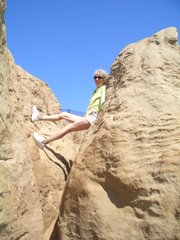 Reading Prompt #6
Reading Prompt #6EGBERT Ch. 6. Inquiry and Problem Solving RICHARDSON Ch. 8. Podcasting and Screencasting: Multimedia Publishing for the Masses
Describe an inquiry or problem solving activity appropriate for ELLs that you have used, participated in, read about, or just now thought of. Describe which critical thinking skills it requires students to use and develop. Then, describe how this activity supports language and content learning for ELLs. Finally, comment on how podcasting could be used within the inquiry and problem solving process in a manner which supports language and content learning for ELLs.
Learning is facilitated by working on problems which are authentic, that is, that have something to do with the student's life. The chapter in Cummins which describes the teacher, Mr. Green's, approach to history by encouraging the students to perform a historiography of their own families, is a great example. Exercises which are engage active, rather than passive learning, have also been shown to be more effective. Like Mr. Green, development by the teacher of ELL of experiences which involve inquiry stoke the natural curiosity of the students, and in turning over the problem solving steps to the students, depending on their competence in the language, learners are motivated and empowered to learn more at a more accelerated pace, and can have more fun. The teacher then takes on the role of consultant rather than boss.
Multi-media is useful, as many different approaches to the same material facilitate the repetition required for learning a foreign language, without the tedium of outright memorization. An electronic wordless worksheet with pictures and audio descriptions could be presented to the learners. The students should all have had exposure to the words, but briefly, in both written and spoken form. The students would be asked to listen to a story containing the concepts pictured via podcast, using the vocabulary introduced, plus a few carefully chosen new words. They would then match the audio descriptions with the pictures by moving the pictures to the proper photograph. Finally, in class, groups of students could prepare sections of the story in their own words using the pictures, and tell the story in round-robin fashion. Each group would have to answer questions from the others concerning unknown words or something not understood.
The critical thinking skills exercised are:
- the ability to distinguish words and sounds from another, and to work with a small body of unknown sounds
- to query if the pictures match the description, and if the student renditions of the story are accurate
- recognizing connections, or lack of connections, between the segments of the stories
- resolve differences and clarify thoughts using L2


2 comments:
The round robin is a good idea. Is the round robin on the story done out loud or do they take turns writing their own parts down? This is a good twist to the lesson "The Neverending Story", which also gives the students the chance to add to a story. Your way is much better because it provides the visual and audio for the language learner.
--Adrienne Padilla
HEllo Carol,
I hope you had a great date with G.S.
We had a really good class night. I will be happy to talk to you about what we learned yesteday. Do you want to meet at around 4:45 next Tuesday? I will be working on a project with Koyen between 5-5:30, so you could watch or even join us - it's the Kidspiration software.
I have the grammar analysys material ready for you. Also, just come on over and visit my class whenever you want. Thanks for your interest.
I found out yesterday that in fact we are moving to Geilenkirchen - unless the air force changes its mind - of course.
I'm very happy about it. I hope to talk to you about German things, how to do this and that. Oh, I'm sooo excited.
Cheers: Rita
Post a Comment